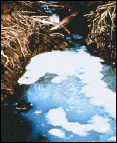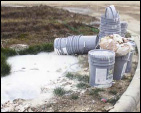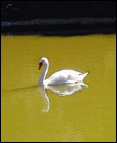Anyone who spends time along the banks of lakes, ponds, or streams knows, water is a dynamic environment. Is conditions can change rapidly and sometimes in mysterious ways. For example, one day mounds of sudsy foam may appear in a stream’s pool, only to disappear the next day. A pleasant pond in the spring can become a stinking, slimy green mess by August. And remote salt marshes may suddenly develop dark pools covered in iridescent purple scum and oily sheens. But are any, or all, of these conditions dangerous? Should you report what you see or are you simply witnessing natural processes?
Below is a table of likely pollution incidents and reporting recommendations.
Water Color |
Possible Cause of Pollution |
Recommended Action |
Images |
Gray Water – water appears milky and may have a rotten egg smell and/or soap odor. There may also be an appearance of cottony slime. |
Human causes may be illicit connections of domestic wastewater to storm drain systems; untreated septic system discharge; illegal boat discharge; and storm water runoff from parking lots. |
Report to the City Health Inspector (603-610-7273) or City Zoning Officer (603-610-7279) |
Gray Water |
Brown Water – water ranging in color from light-tea to chocolate milk; it may have a rotten egg odor. |
Human causes may be eroded, disturbed soils from construction sites, animal enclosures, destabilized stream banks and lake shore erosion due to boat traffic. |
Report to the City Health Inspector (603-610-7273) or City Zoning Officer (603-610-7279) |
Brown Water |
Multi-Color Water – various or uniform color, other than brown, green or gray.
Petroleum based products produce a rainbow sheen on top of the water. |
Human causes may be oil or hazardous waste spill, paint and paint equipment rinsed into storm drains or into failing septic systems.
To confirm a petroleum sheen, disrupt it with a stick. Petroleum sheens don’t easily break apart and quickly flow back together. There are several sources of natural organic oils. |
Call 911 or local Fire Dept. These officials report incidents to NHDES at (603-271-3899) or State Police after hours (603-271-3636). Spills into surface waters and estuaries shall be reported to the EPA’s National Response Center (800-424-8802) |
Multi-color Water
 |
Dry weather pipe discharge – discharges during dry weather conditions that include odors such as sewage, gasoline, or chemical smells; colored water and excessive vegetation around outfall pipes. |
Human causes may be an illegal connection to the storm water drainage system; cross connections between sewer lines and storm drain system; laundry discharges and/or basement floor drains connected to storm rain system |
Report to the Dept of Public Works (603-427-1530) |
|
Green Water – ranging from blue green to bright green color and may impart odor. Conditions typically occur from May through October. |
Human causes may be over-fertilizing lawns, boat discharges, septic systems, agriculture operations, or discharging poorly treated wastewater. |
Report to Conservation Commission and the NH DES Limnology Center (603-271-3414) |
Green Water
 |
Waste paper, plastics, construction materials and food floating on water. |
Trash Dumping |
Report to the Dept. of Public Works (603-427-1530) |
|
Green Flecks – resembling floating blue-green paint chips or grass clippings.
These are known as Cyanobacteria Blooms and are potentially toxic to animals and humans. |
Human causes are excessive nutrients. Fertilizers used on lawns can contaminate surface and ground water. The NH Comprehensive Shoreland Protection Act prohibits the use of all fertilizers except limestone within 25 feet of the reference line of public waters. 25 feet beyond the reference line, low phosphate, slow release nitrogen fertilizer or limestone may be used. |
Report to NH DES Beach Program (603-271-8803); NH DES Limnology Center (603-271-3414) or the Cyanobacteria Hotline (603-419-9229) |
Green Flecks
 |
Foam observed on the surface of lakes and streams.
Natural foam can be brown, black or yellowish and may smell fishy or musty. It breaks apart easily when disturbed. |
Human causes such as leaking sewer lines, boat discharges, or improper sewer connections to storm sewers are common sources of unnatural foam. Also detergents from car washing activities, which smell soapy and do not break apart easily when stirred. |
Report to the City Health Inspector (603-610-7273) or City Zoning Officer (603-610-7279) |
Foam
 |
Green Hair-Like Strands, bright or dark green, resembling cotton candy and often in floating mats. |
Human causes are excessive nutrients from fertilizers or failed on-shore septic systems. |
Report to the City Health Inspector (603-610-7273) or City Zoning Officer (603-610-7279) |
Green Hair-like Strands
 |
Yellow, Brown, or Black Film or coating on water surface – usually in June. |
There are no known human causes overloading the water’s ecology.
Natural causes occur from tree pollen. |
No corrective action need be taken. |
Yellow, Brown, or Black Film
 |
Purple Slime in salt marshes – globs of white slime with a sulfuric odor. |
There are no known human causes overloading the water’s ecology.
Naturally occurring bacteria create these globs. |
No corrective action need be taken. |
Purple Slime
 |
Orange Slime, Fluff or Crust – coating or orange or orange–red materials that covers underwater structures.
Often this material is associated with a surface oily sheen that breaks apart when touched with an object. |
Human causes may be water leaching from a landfill or stump dump. This condition can also occur when land has been excavated or filled for construction.
However, the State’s geologic formations have a great supply of iron – certain bacteria feed on this and excrete a clear jelly-like substance. Therefore it is frequently naturally occurring. |
This condition does not pose a direct environmental threat. However, if conditions persist, contact the Dept. of Public Works (603-427-1530). |
Orange Slime, Fluff or Crust
 |










